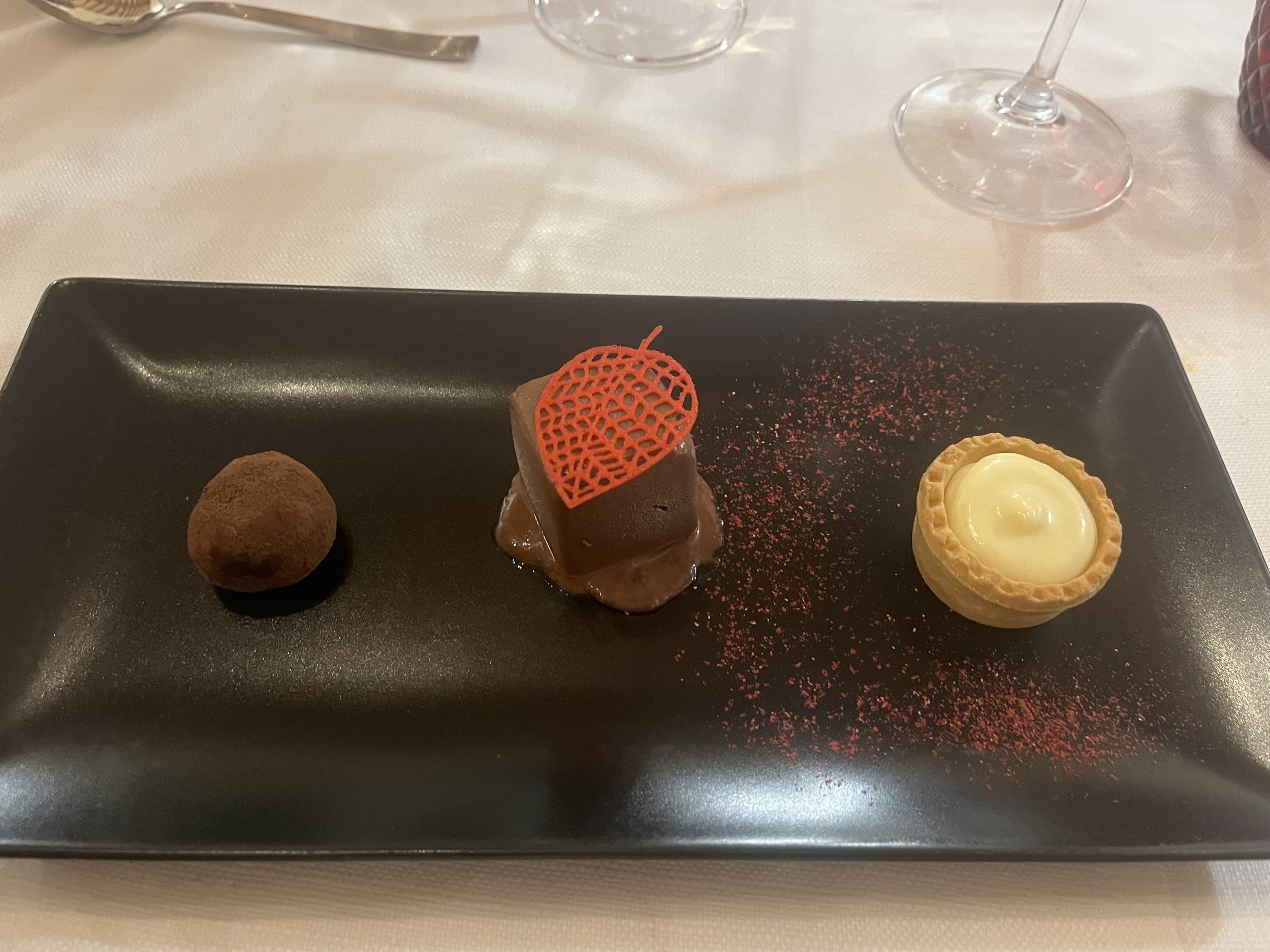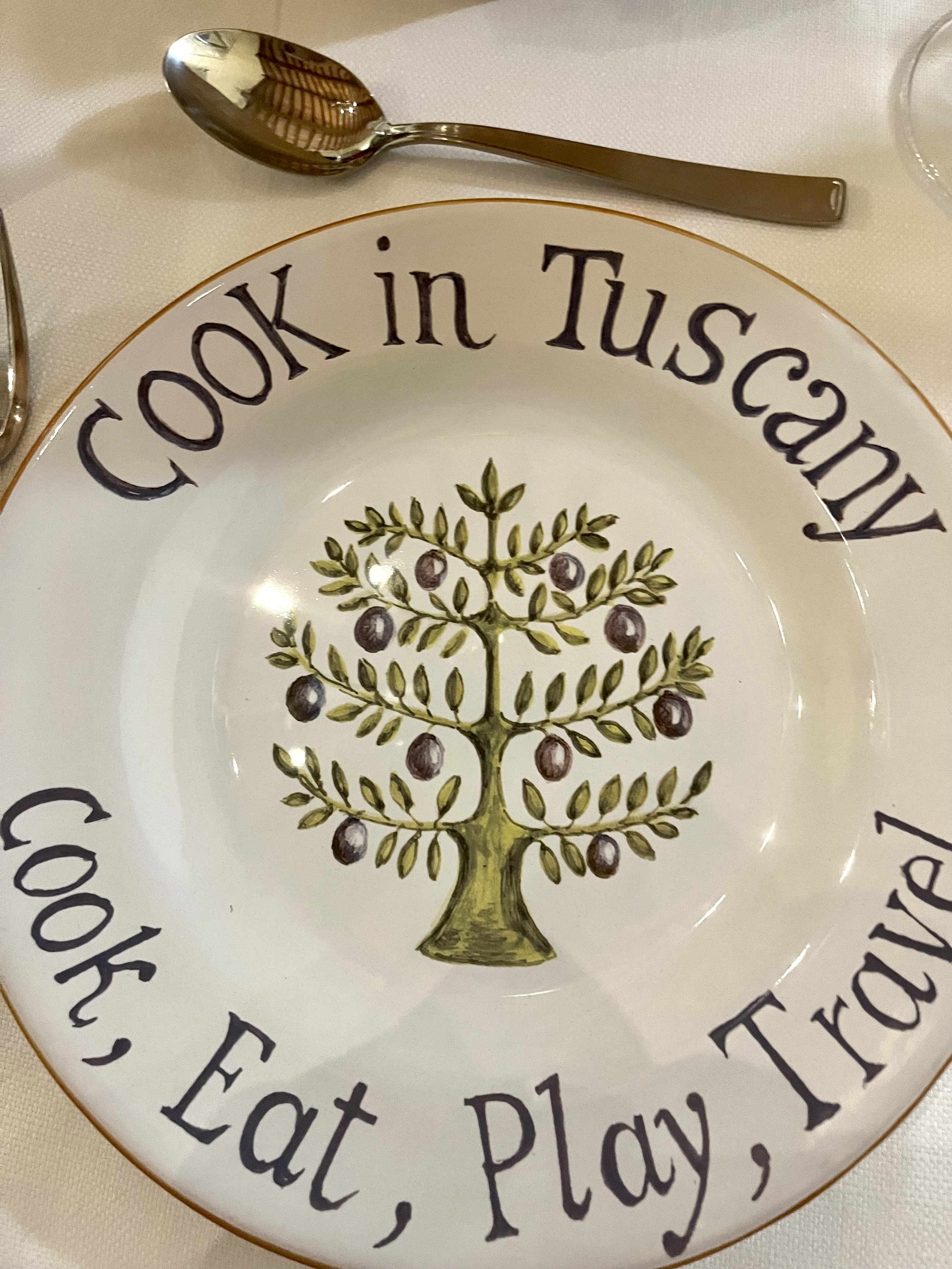Day 6–final cooking day!
Had a flash/crashingly wonderful rainstorm last night which will help the olive harvest in 2 weeks. Awoke to cool blue skies and we realize how fortunate we’ve been to have had lovely moderate temps and sun.
After morning breakfast, our olive oil class was so informative–really had wanted to know more about olive oil:
First thing–olive oil is really a SPICE, rather than just an oil. Good olive oil is used for flavor, not for cooking. If the oil is older, use that for cooking, but for adding flavor, this is what we learned:
First off, there are only two types of olive oil–first press and second press. For flavor, you want First Press AND you want it to be a cold press, meaning it was heated to no more than 27C or 81F
Other things we learned are as follows:
–the color of the oil is superfluous. Makes NO difference. When olive oil sommeliers taste oil, they use dark blue, red, green (etc.) glasses to not be influenced by color
-the flavor is individual. What your partner thinks is “sharp,” you might find rather bland. Taste is personal
-like grapes, olives grown in one part of the grove taste completely different from another area or hill
-unlike similar fruits/grains/etc. used for oil, olive oil is the only thing that uses its FRUIT (not seed) for oil
-both black and green olives are used for oil; black olives ripen longer on the tree. The more black olives, the spicier the oil
-olive oil is blended, just like wine (green to black olive ratio)
-don’t buy plastic or large bottles of olive oil. Be sure the opening of the neck of the container gives little opportunity for oxygen to get in. Store good olive oil for up to 6 months in dark, cool, places. Glass of an oil bottle should be dark.
-Olive oil that has a green stamp with a white leaf overlay is organic. Oil with a number on its neck and a yellow stamp on the bottle is DOP approved as quality oil. Buy it. Oil with labels that include the words “Estratto a Freddo” mean it’s a cold press.
-read labels. Good olive oil should indicate exactly where it’s from, not just indicate “from EU Countries,” etc.
-honey, wine and olive oil are the most counterfeited food items. Some olives are harvested from the ground after falling months before, then washed in bleach and then pressed into olive oil. Yuck. Get quality oil–preferably locally sourced.
The olive oil class consisted of tasting four oils. We held a glass containing a small amount of oil in our palm, and with the other hand, we gripped and swirled the glass. This heated the oil; then we sniffed the oil and finally took a sip. Three of the oils had a rich scent and peppery flavor. One did not–that was the store-bought one. Really–little smell and little flavor. Something to avoid when adding flavor to food.
The group then trudged up the hill to Montefollonico itself–and we enjoyed learning how to make a summertime drink of an Aperol spritzer. Add ice to a glass, then fill with ⅓ Aperol, ⅓ Prosecco, ⅓ sparkling water. Stir, add an orange slice and drink with a straw. This flavor was no my favorite, but many here enjoyed it.
Montefollonico itself has fewer than 200 inhabitants inside the city walls. Another 300 or so live just outside. Quaint, sweet village. We found the market and sampled (and bought) cheese and baking items. Then lunch at 13 Gobbi, a family restaurant. Oh my…what a meal.
The tables are always set up for us with still and sparkling water, with red and white wine. Our first course was tomato on bread with a flavorful olive oil. Then came what I thought was our main course–pasta with parmesan and pepper. The fun part was that the noodles (with a bit of milk) were added to the top of a huge parmesan wheel. The waiter stirred the mixture and the resulting melted cheese clung to the noodles. Delicious.
But…that was just the pasta course. Then came chicken, potatoes, beans, eggplant. All the while, wine flowed and there wasn’t one face that didn’t show anything but delight. The dessert was panna cotta covered with berries. I nearly licked the plate before staggering down the street to La Chiusa for an afternoon nap.
We began our final cooking class with a vengeance again at 5 pm. Stuffed zucchini flowers (which apparently one can buy on Amazon!!), gnocchi, and ravioli. The zucchini flowers weren’t breaded as before, but rather simply filled and drizzled with butter, sprinkled with pine nuts. These will be baked, not deep fried as before.
The gnocchi is made from peeled, boiled potatoes that are riced. Then one adds flour, salt, and a touch of olive oil. The potato dough becomes really stiff. Then it’s cut into “pillows” and you can twirl them a bit on the tip of a fork if you want. These are cooked in hot water.
The ravioli is made with egg pasta dough. It’s rolled thin and a pastry bag is used to dollop ricotta, spinach, nutmeg, salt, pepper, and parmesan cheese mixture onto the dough. Then the dough’s folded over and you use a cookie-cutter type of implement to create individual raviolis. These will be cooked in water for only 3-4 min. and will be slathered with butter and sprinkled with more parmesan cheese.
Things got a bit lively as we all rolled pasta, stuffed blossoms and made the gnocchi and ravioli. The music got us all going and we celebrated the final cooking class in style (with a lot of wine and a few of us dancing unashamedly).
Our final dinner was bittersweet as we knew the cooking clan wouldn’t be together again. We’d already lost Jerry to an early departure and we felt his absence as we prepared our last pasta.
Such a lovely evening and our courses, culminating in a chocolate shabang, left us all with full tummies and hearts full of joy and kinship. George and Linda gifted each of us with a dear plate, but also with an amazing experience. Tomorrow it’s bon voyage!











